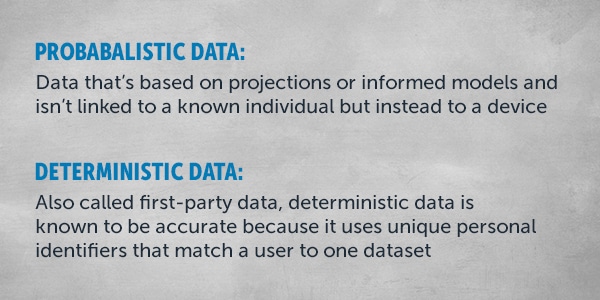Device Graph vs. Identity Graph: Why a Device Graph is Not Enough in 2021

Device graphs rose to prominence with the adoption of smartphones. As more people began to surf the web via their phones instead of just their desktop or laptop computers, marketers were faced with a challenge: How to reach a consumer across their devices. Device graphs sought to provide a solution.
Today, however, a device graph is no longer all you need to reach consumers across their growing number of devices. With the end of third-party cookies in sight, especially, an identity graph is the answer to marketers’ need to effectively leverage data for targeting, execution and measurement.
First of all, what is a device graph?
A device graph is a database or map that stores captured data and information that ties consumer behaviors (e.g., website visits) to devices and compiles them in a meaningful way so that marketers can use them to target, execute or measure media. Device graphs largely rely on cookies or device IDs in order to associate behaviors with devices, however. They typically work off a very small amount of identity data to build models in order to make consumer behavior predictions that are applied to other cookies or device IDs. This is how they provide scalablility for campaigns.
The problem is that the more the identity data is watered down, the less reliable and accurate it becomes and, in turn, results in a decline in performance or a bad user experience with inaccurate messaging or excessively serving the same ad. Additionally, advertisers are unable to properly abide by privacy regulations with unreliable or inaccurate data.
What’s the difference between a device graph and an identity graph?
The biggest differentiator is certainty. By that, what we mean is the ability to knowingly tie an individual to their devices with confidence in a way that doesn’t rely on any kind of probabilistic data like cookies. That’s possible with an identity graph, but not so much with a device graph – in fact, it will become virtually impossible when cookies and device IDs are no longer in play.
Think of it this way: Above, we mentioned that device graphs generally tie consumer behaviors to devices with cookies or device IDs. While there’s a good chance the owner of a specific device is the person using that device at any given time, there’s no way to know for sure who’s actually in front of that screen. With an identity graph, ideally you’re able to build a robust set of anonymized consumer profiles tied to their devices by true identity data, such as email or home address, thereby taking out the guesswork.
Why is a device graph not enough to reach the right audiences these days?
It boils down to the age-old probabilistic versus deterministic discussion. When you’re relying on probabilistic data, you can’t know with absolute certainly who’s using a device. Without some sort of true personal identifier, you can know that a device “behaved” in a certain way, but that’s all you can know for sure. As mentioned above, this can have damaging effects on your campaign efficacy, your measurement results and, ultimately, your budgets.

Think about it this way: Let’s say you’re a brand that has purchased some third-party consumer data. In our small-scale example, say 100 user profiles, perhaps you’re able to confirm who five of these users are, but beyond that, you’re relying on correlations and making educated guesses about the individuals who make up the rest of your dataset. Without a personal identifier – the component made possible by an identity graph – you can’t know for sure who you’re reaching and you’re unable to validate it. That will cause some significant challenges down the road.
What kind of challenges are posed by relying only on a device graph?
Let’s stick with the example from the last answer and amplify it out. The larger your guesswork – and potential for error – becomes, the more you risk significantly wasting your budget. Maybe if you’re spending only a small amount on a small scale and your odds of reaching the right people are great. But we know that’s not enough in advertising – the marketer’s goal is almost always to scale. The more you scale, the more your risk of being incorrect in your assumption of who you’re reaching grows. You can imagine, then, how easily that can result in significant wasted spend.
And then, on top of that, the waste trickles up. If you have the wrong information about who you’re reaching, you’re building your strategies around that misinformation. Your measurement results aren’t accurate, meaning neither are your marketing strategies. These concerns are alleviated when you’re able to connect a consumer to their devices via a stronger identity component, like email address or physical address linked with IP.
The largest challenge ahead is the removal of cookies and device IDs due to upcoming changes being made by Google. This will ultimately render traditional device graphs useless. There is still a lot of discovery and discussion on this topic and how to solve for it. However, an identity graph does provide a pathway for marketers to continue to leverage the consumer data that enables effective advertsing strategies.
How does an identity graph help satisfy privacy concerns?
Certainly, privacy concerns should be top of mind to all marketers today. If a consumer has opted out and doesn’t want their data used, you need to know for sure that you’re not accidentally disobeying their request. But if you’re not certain of who someone is, how do you associate their devices? There’s a big risk factor here if you’re incorrect! Identity data enables effective privacy adherence with the ability to knowingly manage consumer opt outs and other regulations as applicable. Being able to knowingly adhere to all the privacy laws is important, and that’s something made possible by an identity graph.
Does an identity graph replace the need for third-party cookies?
Device graphs generally rely on cookies and device IDs in order to make sense of data. Without these, and without a personal identifier, you’re no longer able to understand consumer behaviors. Basically, if you only use a device graph, without cookies, your ability to target and measure audiences is drastically reduced. That’s why you’ll want to ensure any demand-side platform (DSP) you’re working with leverages an identity graph.
However, when choosing a DSP, it’s extremely important to understand the platform’s approach to identity management. Some rely on a third-party to maintain their identity graph, which means that while they may not be dependent on third-party cookies, you the advertiser and the DSP you are working with are now reliant on other companies over whom you or your DSP have no control or access to transparency. In fact, Viant VP Adam Paz recommends these identity-related questions to ask any potential partners.
Does Viant use an identity graph?
The Viant DSP leverages the power of Viant’s identity resolution capabilities. This universe comprises more than 115 million households, allowing marketers to reach known consumer households with confidence across all of their devices.
By working with a future-proof DSP like Viant, you’re able to scale your advertising efforts and know with confidence that you’re reaching and measuring the response of the right consumer households.
STAY IN THE LOOP WITH OUR NEWSLETTER
Sign up to get Viant news and announcements delivered straight to your inbox.
Sign up to get Viant news and announcements delivered straight to your inbox.
